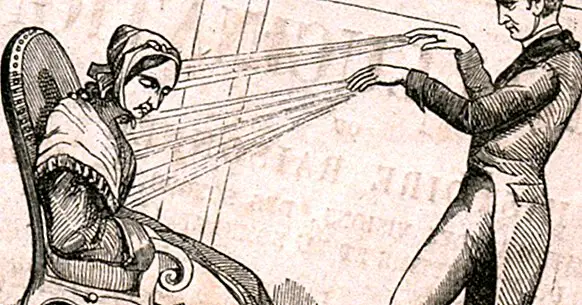The 5 types of hypnosis and how they work
Hypnosis is a method that promotes changes in behavior through suggestion . Depending on the definition on which we base ourselves, we can conceptualize hypnosis as a psychological state or as a set of attitudes and mental processes; Nowadays, the scientific community associates it with expectations or with brain waves.
In this article we will talk about the 5 most common types of hypnosis : the traditional method, which is based on direct verbal suggestion, the one developed by Milton Erickson, cognitive-behavioral hypnosis, self-hypnosis and neurolinguistic programming or NLP, which, without being exactly a form of hypnosis, departs to a large extent from the variant ericksoniana
- Related article: "10 myths about hypnosis, disassembled and explained"
The 5 most popular types of hypnosis
Next we will describe 5 of the best known techniques among which include the use of hypnosis. Of course, there are many other versions and there may be professionals or instruments that combine more than one of these methods.
1. Traditional hypnosis (by suggestion)
The history of traditional hypnosis goes back to the peculiar methods of Franz Mesmer, which involved imams and became popular at the end of the 18th century. Later James Braid showed his opposition to mesmerist hypotheses and proposed that hypnosis was a state of the nervous system, while Pierre Janet attributed it to psychological dissociation.
Traditional hypnosis is based on the induction of a trance state ; Once the hypnotized person has reached it, they will receive suggestions in verbal format in relation to their behavior or their mental contents. Thus, the goal of this method is to influence behavior, for example by suggesting the person to give up a negative habit or belief.
Nowadays, the classical method is still the most used form of hypnosis in the whole world. From a theoretical point of view it is related to the hypothesis of the unconscious mind posed by Freud that marked in a key way the later developments of psychoanalysis, besides influencing orientations as different from this as cognitivism.
- Related article: "Sigmund Freud: life and work of the famous psychoanalyst"
2. Ericksonian hypnosis
This type of hypnosis was developed by Milton H. Erickson, an American psychologist who is considered a pioneer in this field and in psychotherapy in general. Do not confuse this author with Erik Erikson, a German evolutionary psychologist known mainly for his theory of the 8 stages of psychosocial development.
Ericksonian hypnosis is not carried out through direct suggestions, but rather through metaphors that favor creative and reflective thinking . Due to this it is attributed a greater efficacy than to classical hypnosis in people refractory to hypnosis, with a low level of suggestibility or who are skeptical with the procedure.
The influence of Erickson is not limited to hypnosis and neurolinguistic programming, which we will discuss later. The central aspect of its intervention model, the weight of the relationship between the therapist and the client in achieving change, it was picked up by the strategic school and by brief therapy focused on solutions, both part of the systemic approach.
- Maybe you're interested: "Erikson's Theory of Psychosocial Development"
3. Cognitive-behavioral hypnosis
The cognitive-behavioral perspective conceives hypnosis as a set of methods that promote behavioral change through suggestion. This phenomenon is understood as a consequence of the interaction between factors such as state of physical relaxation, the use of imagination or the expectations and beliefs of the person.
Some therapists who engage in cognitive-behavioral counseling use hypnosis techniques as a complement to larger interventions. In this sense it has been applied to problems as varied as alterations of the sleep-wake cycle, behavioral and substance addictions (especially tobacco) or post-traumatic stress disorder.
- Maybe you're interested: "Clinical hypnosis: what does it consist of and how does it work?"
4. Self-hypnosis
We talk about self-hypnosis when a person induces this state through auto-suggestion . Often, instruments that serve as support are used; the most common are the recordings in sound format, although there are also devices that alter brain waves to modify the level of consciousness.
This type of hypnosis is applied especially in daily difficulties that are not particularly serious.Thus, for example, its use is usual to develop intrapersonal and interpersonal skills (such as assertiveness), to reduce the level of stress and induce relaxation, to face stage fright, to lose weight or to stop smoking.
5. Neuro-linguistic programming (NLP)
Although we can not say that it is strictly a type of hypnosis, neurolinguistic programming (which is often referred to as "NLP") is closely related to these methods. This technique created by Richard Bandler and John Grinder uses "thinking models" to improve psychological skills .
The Milton Model is based on the method of hypnosis developed by Milton Erickson; in this variant of NLP, suggestion is practiced through metaphors. However, the use of the intervention of Bandler and Grinder in Ericksonian hypnosis has been criticized because these authors modified or misinterpreted many of their basic ideas.
The scientific community considers neurolinguistic programming as a pseudoscience , and therefore as a fraud. Its postulates are not based on any empirical basis, although it includes complex concepts to provide "theory" with an air of credibility; This type of practice is extremely common in pseudosciences.



















